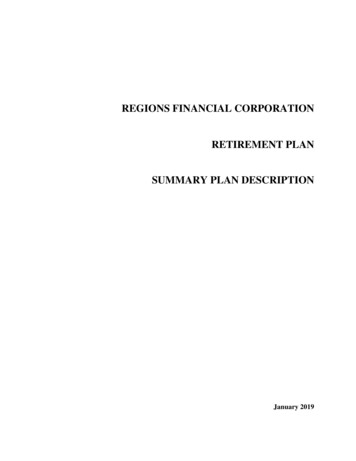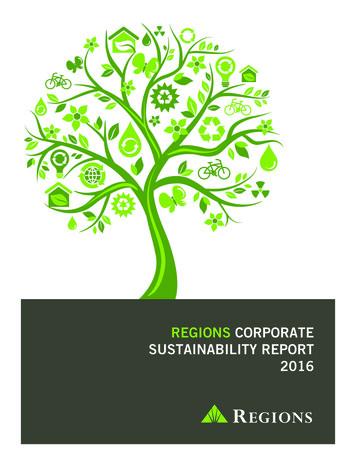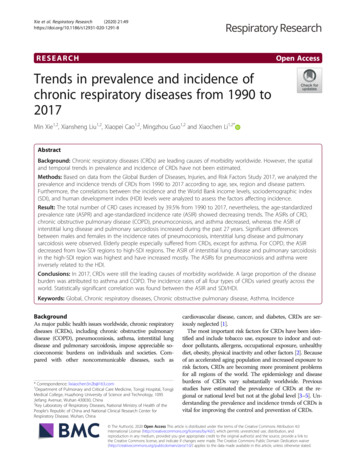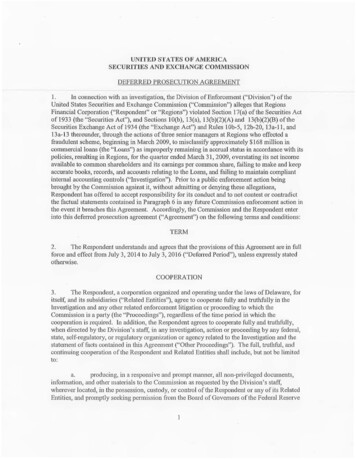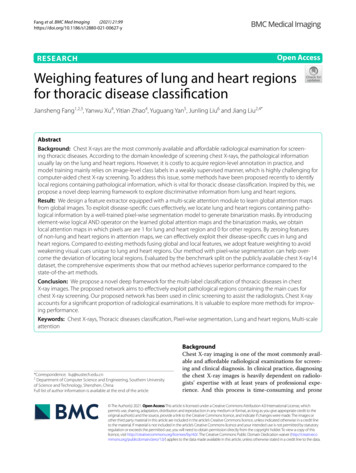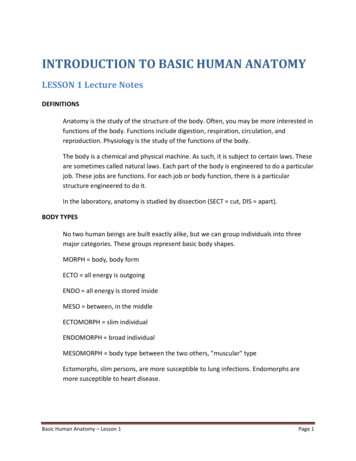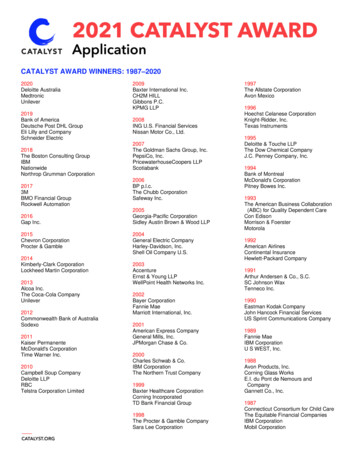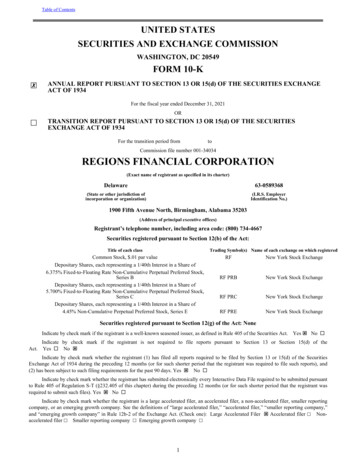
Transcription
Table of ContentsUNITED STATESSECURITIES AND EXCHANGE COMMISSIONWASHINGTON, DC 20549FORM 10-K ANNUAL REPORT PURSUANT TO SECTION 13 OR 15(d) OF THE SECURITIES EXCHANGEACT OF 1934For the fiscal year ended December 31, 2021 ORTRANSITION REPORT PURSUANT TO SECTION 13 OR 15(d) OF THE SECURITIESEXCHANGE ACT OF 1934For the transition period fromtoCommission file number 001-34034REGIONS FINANCIAL CORPORATION(Exact name of registrant as specified in its charter)Delaware63-0589368(State or other jurisdiction ofincorporation or organization)(I.R.S. EmployerIdentification No.)1900 Fifth Avenue North, Birmingham, Alabama 35203(Address of principal executive offices)Registrant’s telephone number, including area code: (800) 734-4667Securities registered pursuant to Section 12(b) of the Act:Title of each classTrading Symbol(s) Name of each exchange on which registeredCommon Stock, .01 par valueDepositary Shares, each representing a 1/40th Interest in a Share of6.375% Fixed-to-Floating Rate Non-Cumulative Perpetual Preferred Stock,Series BDepositary Shares, each representing a 1/40th Interest in a Share of5.700% Fixed-to-Floating Rate Non-Cumulative Perpetual Preferred Stock,Series CDepositary Shares, each representing a 1/40th Interest in a Share of4.45% Non-Cumulative Perpetual Preferred Stock, Series ERFNew York Stock ExchangeRF PRBNew York Stock ExchangeRF PRCNew York Stock ExchangeRF PRENew York Stock ExchangeSecurities registered pursuant to Section 12(g) of the Act: NoneIndicate by check mark if the registrant is a well-known seasoned issuer, as defined in Rule 405 of the Securities Act. Yes ý No Act.Indicate by check mark if the registrant is not required to file reports pursuant to Section 13 or Section 15(d) of theYes No ýIndicate by check mark whether the registrant (1) has filed all reports required to be filed by Section 13 or 15(d) of the SecuritiesExchange Act of 1934 during the preceding 12 months (or for such shorter period that the registrant was required to file such reports), and(2) has been subject to such filing requirements for the past 90 days. Yes ý No Indicate by check mark whether the registrant has submitted electronically every Interactive Data File required to be submitted pursuantto Rule 405 of Regulation S-T (§232.405 of this chapter) during the preceding 12 months (or for such shorter period that the registrant wasrequired to submit such files). Yes ý No Indicate by check mark whether the registrant is a large accelerated filer, an accelerated filer, a non-accelerated filer, smaller reportingcompany, or an emerging growth company. See the definitions of “large accelerated filer,” “accelerated filer,” “smaller reporting company,”and “emerging growth company” in Rule 12b-2 of the Exchange Act. (Check one): Large Accelerated Filer ý Accelerated filer Nonaccelerated filer Smaller reporting company Emerging growth company 1
Table of ContentsIf an emerging growth company, indicate by check mark if the registrant has elected not to use the extended transition period forcomplying with any new or revised financial accounting standards provided pursuant to Section 13(a) of the Exchange Act. Indicate by check mark whether the registrant has filed a report on and attestation to its management’s assessment of the effectivenessof its internal control over financial reporting under Section 404(b) of the Sarbanes-Oxley Act (15 U.S.C.7262(b)) by the registered publicaccounting firm that prepared or issued its audit report. Indicate by check mark whether the registrant is a shell company (as defined in Rule 12b-2 of the Act). Yes No ýState the aggregate market value of the voting and non-voting common equity held by non-affiliates computed by reference to the priceat which the common equity was last sold, or the average bid and asked price of such common equity, as of the last business day of theregistrant’s most recently completed second fiscal quarter.Common Stock, .01 par value— 18,795,418,440 as of June 30, 2021.Indicate the number of shares outstanding of each of the registrant’s classes of common stock, as of the latest practicable date.Common Stock, .01 par value—937,146,134 shares issued and outstanding as of February 22, 2022.DOCUMENTS INCORPORATED BY REFERENCEPortions of the proxy statement for the registrant's 2022 Annual Meeting of Shareholders are incorporated by reference into Part III tothe extent described therein.2
Table of ContentsREGIONS FINANCIAL CORPORATIONFORM 10-KINDEXPagePART ICautionary Note Regarding Forward-Looking Statements and Risk Factor SummaryItem 1.BusinessItem 1A.Risk FactorsItem 1B.Unresolved Staff CommentsItem 2.PropertiesItem 3.Legal ProceedingsItem 4.Mine Safety Disclosures8112238383838PART IIItem 5.Item 6.Item 7.Item 7A.Item 8.Item 9.Item 9A.Item 9B.Item 9C.Market for Registrant's Common Equity, Related shareholder Matters and Issuer Purchasesof Equity Securities[Reserved]Management's Discussion and Analysis of Financial Condition and Results of OperationsQuantitative and Qualitative Disclosures about Market RiskFinancial Statements and Supplementary DataChanges in and Disagreements with Accountants on Accounting and Financial DisclosureControls and ProceduresOther InformationDisclosure Regarding Foreign Jurisdictions that Prevent Inspections4041424288173173173173PART IIIItem 10.Item 11.Item 12.Item 13.Item 14.Directors, Executive Officers and Corporate GovernanceExecutive CompensationSecurity Ownership of Certain Beneficial Owners and Management and Related StockholderMatters174175Certain Relationships and Related Transactions, and Director IndependencePrincipal Accountant Fees and Services175175Exhibits and Financial Statement SchedulesForm 10-K Summary176181182175PART IVItem 15.Item 16.SIGNATURES
Table of ContentsGlossary of Defined TermsAgencies - collectively, FNMA and GNMA.ACL - Allowance for credit losses.ALCO - Asset/Liability Management Committee.ALLL - Allowance for loan and lease losses.Allowance - Allowance for credit losses.AMLA - Anti-Money Laundering Act of 2020AMERIBOR - American Interbank Offered Rate.AOCI - Accumulated other comprehensive income.ASC - Accounting Standards Codification.ARRC - Alternative Reference Rates Committee.Ascentium - Ascentium Capital, LLC., an equipment finance entity acquired April 1, 2020.ASU - Accounting Standards Update.ATM - Automated teller machine.Bank - Regions Bank.Basel III - Basel Committee's 2010 Regulatory Capital Framework (Third Accord).Basel III Rules - Final capital rules adopting the Basel III capital framework approved by U.S. federal regulators in 2013.Basel Committee - Basel Committee on Banking Supervision.BHC - Bank Holding Company.BHC Act - Bank Holding Company Act of 1956, as amended.BITS - Technology policy division of the Bank Policy Institute.Board - The Company’s Board of Directors.BSBY - Bloomberg Short-Term Bank Yield index.Call Report - Regions Bank's FFIEC 031 filing.CAP - Customer Assistance Program.CARES Act - Coronavirus Aid, Relief, and Economic Security Act.CCAR - Comprehensive Capital Analysis and Review.CCB - Capital Conservation Buffer.CECL - Accounting Standards Update 2016-13, Measurement of Credit Losses on Financial Instruments ("CurrentExpected Credit Losses").CEO - Chief Executive Officer.CET1 - Common Equity Tier 1.CFO - Chief Financial Officer.CFPB - Consumer Financial Protection Bureau.CHR - Compensation and Human Resources.Clearsight - Clearsight Advisors, Inc., a mergers and acquisitions firm acquired December 31, 2021.Company - Regions Financial Corporation and its subsidiaries.COSO - Committee of Sponsoring Organizations of the Treadway Commission.COVID-19 - Coronavirus Disease 2019.CPR - Constant (or Conditional) prepayment rate.CRA - Community Reinvestment Act of 1977.DE&I - Diversity, Equity & InclusionDIF - Deposit Insurance Fund.4
Table of ContentsDodd-Frank Act - The Dodd-Frank Wall Street Reform and Consumer Protection Act of 2010.DPD - Days past due.DUS - Fannie Mae Delegated Underwriting & Servicing.E&P - Extraction and production.EAD - Exposure-at-default.EEO-1 - Equal employment opportunity commission's standard form 100 reportEGRRCPA - The Economic Growth, Regulatory Relief, and Consumer Protection Act.EnerBank - EnerBank USA, a consumer lending institution acquired October 1, 2021.ESG - Environmental, Social and Governance.ETS - Emergency Temporary StandardEU - European UnionFASB - Financial Accounting Standards Board.FCA - Financial Conduct Authority.FDIA - Federal Deposit Insurance Act, as amended.FDIC - The Federal Deposit Insurance Corporation.Federal Reserve - The Board of Governors of the Federal Reserve System.FFIEC - Federal Financial Institutions Examination Council.FHA - Federal Housing Administration.FHC - Financial Holding Company.FHLB - Federal Home Loan Bank.FICO - The Financing Corporation, established by the Competitive Equality Banking Act of 1987.FICO scores - Personal credit scores based on the model introduced by the Fair Isaac Corporation.FinCEN - the Financial Crimes Enforcement Network.FINRA - Financial Industry Regulatory Authority.Fintechs - Financial Technology Companies.FNMA - Federal National Mortgage Association, known as Fannie Mae.FOMC - Federal Open Market Committee.FRB - Federal Reserve Bank.FS-ISAC - Financial Services - Information Sharing & Analysis Center.FTP - Funds Transfer Pricing.GAAP - Generally Accepted Accounting Principles in the United States.GDP - Gross domestic product.GNMA - Government National Mortgage Association.G-SIB - Globally Systematically Important Bank Holding Company.HPI - Housing price index.HUD - U.S. Department of Housing and Urban Development.HCM - Human Capital Management.IPO - Initial public offering.IRA - Individual Retirement Account.IRE - Investor real estate portfolio segment.IRS - Internal Revenue Service.ISM - Institute for Supply Management.5
Table of ContentsLCR - Liquidity coverage ratio.LGD - Loss given default.LIBOR - London InterBank Offered Rate.LLC - Limited Liability Company.LROC - Liquidity Risk Oversight Committee.LTIP - Long-term incentive plan.LTV - Loan to value.MBS - Mortgage-backed securities.M&A - Mergers and acquisitions.MD&A - Management’s Discussion and Analysis of Financial Condition and Results of Operations.MSAs - Metropolitan Statistical Areas.MSR - Mortgage servicing right.NAV - Net Asset Value.NM - Not meaningful.NSFR - Net stable funding ratio.NYSE - New York Stock Exchange.OAS - Option-adjusted spread.OCC - Office of the Comptroller of the Currency.OCI - Other comprehensive income.OFAC - U.S. Treasury Department - Office of Foreign Assets Control.OIS - Overnight indexed swap.OLA - Orderly Liquidation Authority.PCD - Purchased credit deteriorated.PCE - Personal Consumption Expenditure.PD - Probability of default.PPP - Paycheck Protection Program.R&S - Reasonable and supportable.Raymond James - Raymond James Financial, Inc.REIT - Real estate investment trust.Regions Securities - Regions Securities LLC.RETDR - Reasonable expectation of a troubled debt restructuring.RWAs - Risk-weighted assets.S&P 500 - a stock market index that measures the stock performance of 500 large companies listed on stock exchanges inthe United States.Sabal - Sabal Capital Partners, LLC, a diversified financial services firm acquired December 1, 2021.SBA - Small Business Administration.SBIC - Small Business Investment Company.SCB - Stress Capital Buffer.SEC - U.S. Securities and Exchange Commission.SERP - Supplemental Executive Retirement Plan.SOFR - Secured Overnight Financing Rate.TBA - To Be Announced.TDR - Troubled debt restructuring.6
Table of ContentsTRACE - Trade Reporting and Compliance Engine.TTC - Through-the-cycle.U.K. - United Kingdom.U.S. - United States.USA PATRIOT Act - Uniting and Strengthening America by Providing Appropriate Tools Required to Intercept andObstruct Terrorism Act of 2001.U.S. Treasury - The United States Department of the Treasury.USD - United States dollar.UTB - Unrecognized tax benefits.VIE - Variable interest entity.Visa - The Visa, U.S.A. Inc. card association or its affiliates, collectively.wSTWF - Weighted short-term wholesale funding.7
Table of ContentsPART ICautionary Note Regarding Forward-Looking Statements and Risk Factor SummaryThis Annual Report on Form 10-K, other periodic reports filed by Regions Financial Corporation under the SecuritiesExchange Act of 1934, as amended, and any other written or oral statements made by us or on our behalf to analysts, investors,the media and others, may include forward-looking statements as defined in the Private Securities Litigation Reform Act of1995. The words “future,” “anticipates,” “assumes,” “intends,” “plans,” “seeks,” “believes,” “predicts,” “potential,”“objectives,” “estimates,” “expects,” “targets,” “projects,” “outlook,” “forecast,” “would,” “will,” “may,” “might,” “could,”“should,” “can,” and similar terms and expressions often signify forward-looking statements. Forward-looking statements aresubject to the risk that the actual effects may differ, possibly materially, from what is reflected in those forward-lookingstatements due to factors and future developments that are uncertain, unpredictable and in many cases beyond our control,including the scope and duration of the COVID-19 pandemic (including the impact of additional variants and resurgences), theeffectiveness, availability and acceptance of any vaccines or therapies, and the direct and indirect impact of the COVID-19pandemic on our customers, third parties and us. Forward-looking statements are not based on historical information, but ratherare related to future operations, strategies, financial results or other developments. Forward-looking statements are based onmanagement’s current expectations as well as certain assumptions and estimates made by, and information available to,management at the time the statements are made. Those statements are based on general assumptions and are subject to variousrisks, and because they also relate to the future they are likewise subject to inherent uncertainties and other factors that maycause actual results to differ materially from the views, beliefs and projections expressed in such statements. Therefore, wecaution you against relying on any of these forward-looking statements. These risks, uncertainties and other factors include, butare not limited to, the risks identified in Item 1A. “Risk Factors” of this Annual Report on Form 10-K and those describedbelow: Current and future economic and market conditions in the United States generally or in the communities we serve (in particularthe Southeastern United States), including the effects of possible declines in property values, increases in unemployment rates,financial market disruptions and potential reductions of economic growth, which may adversely affect our lending and otherbusinesses and our financial results and conditions. Possible changes in trade, monetary and fiscal policies of, and other activities undertaken by, governments, agencies, centralbanks and similar organizations, which could have a material adverse effect on our earnings. Possible changes in market interest rates or capital markets could adversely affect our revenue and expense, the value of assetsand obligations, and the availability and cost of capital and liquidity. The impact of pandemics, including the ongoing COVID-19 pandemic, on our businesses, operations, and financial results andconditions. The duration and severity of any pandemic, including the COVID-19 pandemic, could disrupt the global economy,adversely affect our capital and liquidity position, impair the ability of borrowers to repay outstanding loans and increase ourallowance for credit losses, impair collateral values, and result in lost revenue or additional expenses. Any impairment of our goodwill or other intangibles, any repricing of assets, or any adjustment of valuation allowances on ourdeferred tax assets due to changes in tax law, adverse changes in the economic environment, declining operations of thereporting unit or other factors. The effect of new tax legislation and/or interpretation of existing tax law, which may impact our earnings, capital ratios, and ourability to return capital to shareholders. Possible changes in the creditworthiness of customers and the possible impairment of the collectability of loans and leases,including operating leases. Changes in the speed of loan prepayments, loan origination and sale volumes, charge-offs, credit loss provisions or actual creditlosses where our allowance for credit losses may not be adequate to cover our eventual losses. Possible acceleration of prepayments on mortgage-backed securities due to low interest rates, and the related acceleration ofpremium amortization on those securities. Loss of customer checking and savings account deposits as customers pursue other, higher-yield investments, which couldincrease our funding costs. Possible changes in consumer and business spending and saving habits and the related effect on our ability to increase assetsand to attract deposits, which could adversely affect our net income. Our ability to effectively compete with other traditional and non-traditional financial services companies, including fintechs,some of whom possess greater financial resources than we do or are subject to different regulatory standards than we are. Our inability to develop and gain acceptance from current and prospective customers for new products and services and theenhancement of existing products and services to meet customers’ needs and respond to emerging technological trends in atimely manner could have a negative impact on our revenue.8
Table of Contents Our inability to keep pace with technological changes, including those related to the offering of digital banking and financialservices, could result in losing business to competitors. Changes in laws and regulations affecting our businesses, including legislation and regulations relating to bank products andservices, as well as changes in the enforcement and interpretation of such laws and regulations by applicable governmental andself-regulatory agencies, including as a result of the changes in U.S. presidential administration, control of the U.S. Congress,and changes in personnel at the bank regulatory agencies, which could require us to change certain business practices, increasecompliance risk, reduce our revenue, impose additional costs on us, or otherwise negatively affect our businesses. Our capital actions, including dividend payments, common stock repurchases, or redemptions of preferred stock, must not causeus to fall below minimum capital ratio requirements, with applicable buffers taken into account, and must comply with otherrequirements and restrictions under law or imposed by our regulators, which may impact our ability to return capital toshareholders. Our ability to comply with stress testing and capital planning requirements (as part of the CCAR process or otherwise) maycontinue to require a significant investment of our managerial resources due to the importance of such tests and requirements. Our ability to comply with applicable capital and liquidity requirements (including, among other things, the Basel III capitalstandards), including our ability to generate capital internally or raise capital on favorable terms, and if we fail to meetrequirements, our financial condition and market perceptions of us could be negatively impacted. The effects of any developments, changes or actions relating to any litigation or regulatory proceedings brought against us orany of our subsidiaries. The costs, including possibly incurring fines, penalties, or other negative effects (including reputational harm) of any adversejudicial, administrative, or arbitral rulings or proceedings, regulatory enforcement actions, or other legal actions to which we orany of our subsidiaries are a party, and which may adversely affect our results. Our ability to manage fluctuations in the value of assets and liabilities and off-balance sheet exposure so as to maintainsufficient capital and liquidity to support our businesses. Our ability to execute on our strategic and operational plans, including our ability to fully realize the financial and nonfinancialbenefits relating to our strategic initiatives. The risks and uncertainties related to our acquisition or divestiture of businesses, including our recently completed acquisitionsof EnerBank, Sabal, and Clearsight, and risks related to such acquisitions, including that the expected synergies, cost savingsand other financial or other benefits may not be realized within the expected timeframes, or might be less than projected;difficulties in integrating the businesses; and the inability of Regions to effectively cross-sell products following theseacquisitions. The success of our marketing efforts in attracting and retaining customers. Our ability to recruit and retain talented and experienced personnel to assist in the development, management and operation ofour products and services may be affected by changes in laws and regulations in effect from time to time. Fraud or misconduct by our customers, employees or business partners. Any inaccurate or incomplete information provided to us by our customers or counterparties. Inability of our framework to manage risks associated with our businesses, such as credit risk and operational risk, includingthird-party vendors and other service providers, which could, among other things, result in a breach of operating or securitysystems as a result of a cyber attack or similar act or failure to deliver our services effectively. Dependence on key suppliers or vendors to obtain equipment and other supplies for our businesses on acceptable terms. The inability of our internal controls and procedures to prevent, detect or mitigate any material errors or fraudulent acts. The effects of geopolitical instability, including wars, conflicts, civil unrest, and terrorist attacks and the potential impact,directly or indirectly, on our businesses. The effects of man-made and natural disasters, including fires, floods, droughts, tornadoes, hurricanes, and environmentaldamage (specifically in the Southeastern United States), which may negatively affect our operations and/or our loan portfoliosand increase our cost of conducting business. The severity and frequency of future earthquakes, fires, hurricanes, tornadoes,droughts, floods and other weather-related events are difficult to predict and may be exacerbated by global climate change. Changes in commodity market prices and conditions could adversely affect the cash flows of our borrowers operating inindustries that are impacted by changes in commodity prices (including businesses indirectly impacted by commodities pricessuch as businesses that transport commodities or manufacture equipment used in the production of commodities), which couldimpair their ability to service any loans outstanding to them and/or reduce demand for loans in those industries.9
Table of Contents Our ability to identify and address cyber-security risks such as data security breaches, malware, ransomware, “denial ofservice” attacks, “hacking” and identity theft, including account take-overs, a failure of which could disrupt our businesses andresult in the disclosure of and/or misuse or misappropriation of confidential or proprietary information, disruption or damage toour systems, increased costs, losses, or adverse effects to our reputation. Our ability to achieve our expense management initiatives. Market replacement of LIBOR and the related effect on our LIBOR-based financial products and contracts, including, but notlimited to, derivative products, debt obligations, deposits, investments, and loans. Possible downgrades in our credit ratings or outlook could, among other negative impacts, increase the costs of funding fromcapital markets. The effects of problems encountered by other financial institutions that adversely affect us or the banking industry generallycould require us to change certain business practices, reduce our revenue, impose additional costs on us, or otherwise negativelyaffect our businesses. The effects of the failure of any component of our business infrastructure provided by a third party could disrupt our businesses,result in the disclosure of and/or misuse of confidential information or proprietary information, increase our costs, negativelyaffect our reputation, and cause losses. Our ability to receive dividends from our subsidiaries, in particular Regions Bank, could affect our liquidity and ability to paydividends to shareholders. Changes in accounting policies or procedures as may be required by the FASB or other regulatory agencies could materiallyaffect our financial statements and how we report those results, and expectations and preliminary analyses relating to how suchchanges will affect our financial results could prove incorrect. Fluctuations in the price of our common stock and inability to complete stock repurchases in the time frame and/or on the termsanticipated. The effects of anti-takeover and exclusive forum laws and provision in our certificate of incorporation and bylaws. The effects of any damage to our reputation resulting from developments related to any of the items identified above. Other risks identified from time to time in reports that we file with the SEC.You should not place undue reliance on any forward-looking statements, which speak only as of the date made. Factors orevents that could cause our actual results to differ may emerge from time to time, and it is not possible to predict all of them.We assume no obligation and do not intend to update or revise any forward-looking statements that are made from time to time,either as a result of future developments, new information or otherwise, except as may be required by law.10
Table of ContentsItem 1. BusinessRegions Financial Corporation is a FHC headquartered in Birmingham, Alabama operating in the South, Midwest andTexas. In addition, Regions operates several offices delivering specialty capabilities in New York, Washington D.C., Chicagoand other locations nationwide. Regions provides financial solutions for a wide range of clients including retail and mortgagebanking services, commercial banking services and wealth and investment services. Further, Regions and its subsidiariesdeliver specialty capabilities including merger and acquisition advisory services, capital market solutions, home improvementlending and others. At December 31, 2021, Regions had total consolidated assets of approximately 162.9 billion, totalconsolidated deposits of approximately 139.1 billion and total consolidated shareholders’ equity of approximately 18.3billion.The terms “Regions,” the “Company,” “we,” “us” and “our” as used herein mean collectively Regions FinancialCorporation, a Delaware corporation, together with its subsidiaries when or where appropriate. Its principal executive officesare located at 1900 Fifth Avenue North, Birmingham, Alabama 35203, and its telephone number at that address is(800) 734-4667.Banking OperationsRegions conducts its banking operations through Regions Bank, an Alabama state-chartered commercial bank that is amember of the Federal Reserve System. At December 31, 2021, Regions operated 2,068 ATMs and 1,302 total branch outletsprimarily across the South, Midwest and Texas.The following table reflects the distribution of branch locations in each of the states in which Regions conducts itsbanking inoisSouth CarolinaKentuckyNorth 117511,302Other Financial Services OperationsIn addition to its banking operations, Regions provides additional financial services through the following subsidiaries:Regions Equipment Finance Corporation and Regions Commercial Equipment Finance, LLC, each a wholly-ownedsubsidiary of Regions Bank, provide equipment financing products focusing on commercial clients. Ascentium Capital, also awholly-owned subsidiary of Regions Bank, provides financing of essential-use equipment for small business customers througha technology-enabled model that delivers same-day credit decisions and funding.Regions Investment Services, Inc., a wholly-owned subsidiary of Regions Bank, offers investments and insuranceproducts to Regions Bank customers, provided by licensed insurance agents. In addition, Regions Bank and Regions InvestmentServices, Inc. also maintain an agreement with Cetera Investment Services, LLC to offer securities, insurance and advisoryservices to Regions Bank customers through dually-employed financial advisors.Regions Securities LLC, a wholly-owned subsidiary of Regions headquartered in Atlanta, Georgia, serves as a brokerdealer to commercial clients and acts in an advisory capacity to merger and acquisition transactions.11
Table of ContentsBlackArch Partners LLC is a wholly-owned subsidiary of Regions and is headquartered in Charlotte, North Carolina.BlackArch Partners LLC and its broker-dealer subsidiary offer merger and acquisition services to its institutional clients andcommercial entities, as well as serving as a broker-dealer to commercial clients.Clearsight Advisors, Inc. is a wholly-owned subsidiary of Regions headquartered in McLean, Virginia, and acts in anadvisory capacity to merger and acquisition transactions.Sabal Capital Partners, LLC, is a wholly-owned subsidiary of Regions Bank headquartered in Irvine, California, and is anational commercial real estate lender.Regions Investment Management, Inc. serves as the investment adviser to Regions Wealth Management division andtrades in stocks and bonds for trust clients. Highland Associates, Inc. is an institutional investment firm providing investmentcounsel and consulting services
BHC - Bank Holding Company. BHC Act - Bank Holding Company Act of 1956, as amended. BITS - Technology policy division of the Bank Policy Institute. Board - The Company's Board of Directors. BSBY - Bloomberg Short-Term Bank Yield index. Call Report - Regions Bank's FFIEC 031 filing. CAP - Customer Assistance Program.
